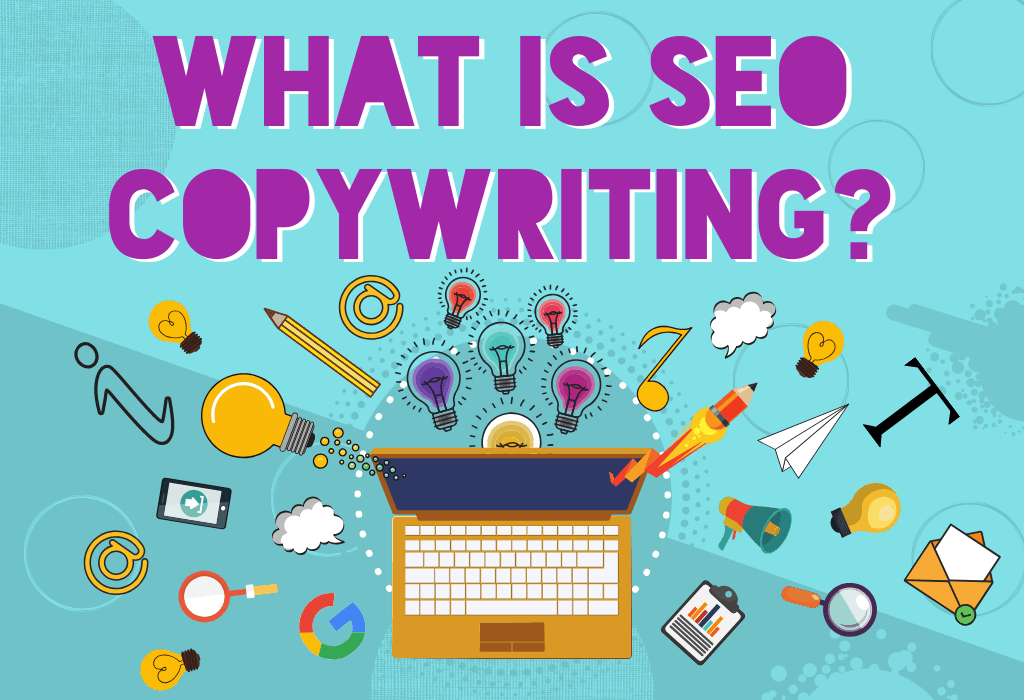I'm sure you've seen a blog post title like this before. You know what I'm talking about where it's filled with acronyms and words no one actually uses, right?
Well, those posts suck because these posts don’t seem helpful at all (except for the writer who wrote them obviously). That’s why mega-companies never write for their products themselves.
For instance, a small business in Lahore will hire services from the best SEO company in Lahore to provide them with top-notch content that aligns with their ideal audience.
But if you would like to learn how to write content that both people and search engines love, then read on.

Today we're going over SEO copywriting — why it's important, should you learn it yourself or hire the best SEO agency in Leeds to handle your company projects.
Let’s start from the basics and what it takes to write for search engines and audiences alike.
What is SEO Copywriting?
SEO Copywriting is about writing content that search engines rank and customers love to read and convert.
Not many people know this, but Google wants to provide their users with the absolute best results. They want to give them what they're looking for — nothing more and nothing less.
That's why some articles or websites might rank higher than others.
When it comes to SEO copywriting, keywords are pretty important as they say hint to search engines what your brand is all about.
But don't stuff them into your titles or content just to rank higher. That's what everyone does now, and it just makes your content look spammy.
The trick is to use your keywords naturally within your writing instead of shoving all of them into your title or at the beginning of every sentence.
If you want your content to rank on the search engines, it needs to be SEO optimized. That means using the right keyword, placing it in the right place, and delivering useful content that provides value.
That's what SEO copywriting is all about: Using keywords strategically to make sure you rank for the topics your potential customers are searching for without making it sound salesy.
Because if you're not ranking, then no one can find your website (and that would be tragic).
The first thing to keep in mind is this: people are smarter than search engines; they'll understand what you're talking about so till now if you have been writing for search engines only, change your strategy.
Let’s talk about headlines first. Shouldn’t we?
Now that you understand SEO copywriting a little bit better, I want to share with you some helpful tips that will help you write your blog titles (and ultimately, the content itself).
What Makes a Good Title?
There are some important qualities to look for in a title:
Your title must be descriptive enough to give you a sense of what the article will be about. It should include numbers to let readers know they'll learn something new.
It's actionable — so people can do it or at least start doing it. It invites curiosity and makes them click through to read more.
If your title gets someone curious enough, they'll click on it. And then Google will see how many people are clicking through to your website and reward you with higher rankings.
It's that simple!
The best way to come up with a headline is to ask yourself this question: "What do my customers want?"
For instance, if you are an SEO agency in Pakistan, what would your customers want to hear the most? Maybe some actionable SEO tips or know about the latest SEO tools?
Then try using that as a title. It makes sense!
If you spend your days reading blogs and websites, you'll notice the same type of posts over and over again. They all share one thing - which is a powerful headline that hooks readers.
That's what we want to focus on today — writing titles for your ideal audience, not search engines.
The more specific the better. It's about quality, not quantity. You can easily expand on a topic later on in the post or add it as a reference link at the bottom.
But even if they don't click, you can still come up with titles that sound intriguing enough for them to read more about it. If the article is long enough, they may even bookmark it for later.
Elements of SEO Copywriting
Here are the 5 elements of SEO copywriting that matter:
- People: What you write for people, not search engines. Even if Google ranks you on the first page, but your content doesn’t align with the audience, it will increase your bounce rate.
- Keyword: You need to use this strategically without compromising the user experience. Long-tail keywords will improve your Google ranking and provide more benefits than broad keywords.
- Tone: Your tone should be conversational and helpful, but not dumbed down so much that it sounds like a robot wrote the content.
- Style: Your writing style should be concise, clear and easy to understand. You can also add a light sprinkling of personality!
- Clarity: Make your point quickly, while being thorough and not vague. Structure- Organize your paragraphs so they flow effortlessly from one idea to the other.
How to Write Copy Using These Elements?
When writing copy, you need to consider all of these elements. It takes time, but it's worth the effort you put into it.
And remember to follow these steps each time even you write a blog post:
Write for your audience, not Google (writing for an audience is ultimately writing for Google). Come up with your headline first, before writing anything else.
Write using numbers and action words that are descriptive, unique and bold.
Write in your own voice. Don't overuse keywords, but use them strategically to target long-tail keywords that are relevant to your article's topic.
Make it easy for the reader by writing clear and concise sentences with short paragraphs that flow from one point to another naturally.
Edit out all unnecessary words or sentences so you have a lean, mean piece of content.
Follow Up with the Main Content of Your Blog Post
After that, all you have to do is fill in the gaps with a few subheadings and pull quotes, and then tag it with a catchy image. And you're done!
It's really not as complicated as it seems at first glance. In fact, once you understand SEO copywriting, it becomes second nature to write content this way.
Don't forget: Google wants organic results from trusted websites. So make sure to take this into consideration when writing your content!
An SEO company in Lahore or anywhere in Pakistan will never ever compromise on their content strategy because - copywriting sells but it needs to persuade people to take action but aligning your content with Google is also important.
Never forget that your content should be useful and actionable; it should make people's lives easier. Because at the end of the day, that's what it's all about: building a brand.
A brand doesn't just mean a name or a logo; it means trustworthiness and authority in your industry.
People need to know you can help them solve their problems or answer their questions before they'll ever buy from you…or even read another one of your articles!
Now Let's talk about the most important part of copywriting:
Research
If you are not spending time researching your target audience, doesn’t matter how much effort you put in writing, you will always never persuade your audience to pull the trigger and buy from you.
Research is the most crucial element of copywriting. If I say research is 80% and words are only 20% part of a copy. It holds true.
And it's also one of the most difficult parts. But it's worth doing well because you won't get anywhere if no one reads your content!
Step 1: First, you need to know who your ideal clients are, what problems they have and how to solve them. You need to become an expert in their field so you can be the go-to authority that people trust for advice.
Step 2: Then do some keyword research to find out which long-tail keywords to find their relevancy to your articles' topic…but don't overdo it!
Remember, Google doesn't want every guest blog post trying to rank for the same keyword phrases, so mix up your keywords.
Where to Find the Pain Points of Your Readers?
Look at the most popular posts on your blog and see what keywords they rank for in search engines.
Don't forget that Google Analytics provides a wealth of information about who is coming to your site and what they're searching for when they get there.
And don't forget to use Twitter, Quora and Reddit to find out what people are searching for!
The best way to cover audience needs and desires is to talk to them where they mostly hang, which means social listening.
Respond to comments and messages on your social media platforms so you can see how they respond to your content.
Make posts in relevant groups on Social media and see what people comment about. Gather the data, do your analysis and write content that is 100% customer-oriented.
And don't forget about forums and Q & A sites where people ask questions about the issues that concern them the most!
And now, let's go over some of the best strategies for ranking your content on search engines.
Best Practices for Optimizing Your Content
Here are the best practices to keep in mind when optimizing your content for SEO:
Call to Action:
Create a call to action (CTA) at the end of each blog post you publish. But make sure it fits with what you've already written about; otherwise, people won't know whether they should take action or not.
Optimize Your Meta Description:
Use keywords in your title tags and meta description, but don't overdo it. Just use them enough so Google knows what your content is about without stuffing too many keywords in there!
Create Linking with Authority Sites:
Link out to other people in your industry when it makes sense. This can help you build relationships with influencers who'll be more likely to share your content with their followers.
And the more people talk about you, the more traffic you'll get…so don't be afraid of a little self-promotion every once in a while!
In conclusion
Finally, make sure to include these elements on each new post you publish:
Write for your audience not to rank on Google. If your audience appreciates your content, so will Google and vice versa.
Come up with a catchy headline before writing anything else. Write using a simple, conversational tone. Include a CTA at the end of your post.
Remember, SEO copywriting is all about creating high-quality content that people will actually want to read!
It's not about doing everything you can to rank higher; it's not even about getting website visitors. It's about creating something people will benefit from. So don't be afraid to get creative and experiment with your content!
In the end, Google's job is to show people what they're looking for…so don't be afraid to give them exactly that!

Benita lights up Websouls with her flair for content creation, bringing over 4 years of magic to the table. She has a knack for crafting stories that stick and making words dance. Her playful touch and creative spark turn ideas into engaging content that everyone loves. Benita's the word wizard of the team! LinkedIn.
 PKR (Rs)
PKR (Rs)
 USD ($)
USD ($)
